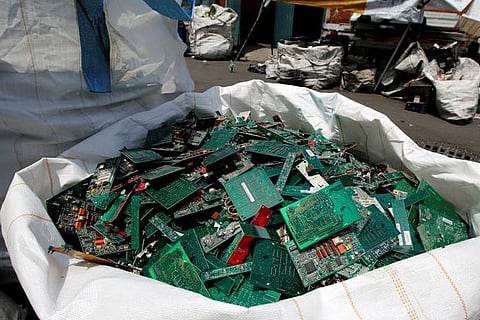

Chennai
Most people think they know what waste is. It’s the plastic they rip off their broccoli and toss in the bin. It’s the cardboard box their new laptop arrives in, and that laptop itself, once it’s no longer useful. Every year, the world produces roughly 2 billion metric tons of garbage. But this is just the trash we can see. “The waste we deal with as consumers is a tiny percentage of the overall waste — only about 2 to 3% of it,” said Josh Lepawsky, author of a book on the global impact of making digital technology. Hidden in the difficult-to-trace processes of resource extraction, manufacturing, transportation and electricity production is the bulk of the world’s waste — generated to make the stuff we buy.
This is especially true for electronics, which is the world’s fastest growing trash stream and one of the largest sources of invisible waste.
“Most of the pollution and waste from electronics happens long before people have their devices in their hands,” said Lepawsky, who is also a professor of geography at the Memorial University of Newfoundland in St. John’s, Canada. Producing electronics involves high levels of hazardous chemicals, greenhouse gases and water drainage.
Most of this is totally invisible to the average consumer and difficult to quantify. Electronics are comprised of numerous components, most of them sourced and manufactured in different locations around the world before being assembled somewhere else entirely. A typical smartphone, for example, can comprise up to 62 different metals.
Among the myriad tiny components of an Apple iPhone are gold, silver and palladium. These precious metals — extracted mostly in Asia, Africa and Australia — need to be mined.
A study by Swedish waste management and recycling association Avfall Sverige calculated the invisible waste generated for a typical smartphone and 3-kilogram laptop to be about 86 and 1,200 kilograms (190 and 2,645 pounds) respectively.
“That figure includes stones, gravel, tailings and slag,” said Anna Carin Gripwall, co-author of the study. “It’s also the fuel and electricity used — but that is a very small amount compared to the mining waste.” This far outweighs other products surveyed, including 1 kilogram of beef and a pair of cotton trousers, which generate 4 and 25 kilograms respectively.
The cutting, drilling, blasting, transportation and processing involved in mining precious metals can release dust containing harmful metals and chemicals into the air and surrounding water sources.
“After you dig up the ore, you have to separate out the concentrated material,” said Fu Zhao, professor of mechanical engineering at Purdue University in the US state of Indiana. “They are difficult to break down, so you need to use chemicals and high temperatures.” This becomes particularly problematic when done on such a large scale, he added.
Without proper oversight, these toxic components can contaminate groundwater, leach into valleys and streams and damage soil, plants and animals — and threaten the health of human populations. This doesn’t necessarily mean that mining for these precious metals is inherently bad for the environment, said Saleem Ali, professor of energy and environment at the University of Delaware in the US. “The challenge is just figuring out how to manage it so it doesn’t damage the environment,” he said. “You have to find a way that these toxic solvents don’t enter the groundwater supply, and give people working in these areas protective equipment so they aren’t inhaling volatile organics.” This can be done,
- This article was provided by Deutsche Welle
Visit news.dtnext.in to explore our interactive epaper!
Download the DT Next app for more exciting features!
Click here for iOS
Click here for Android